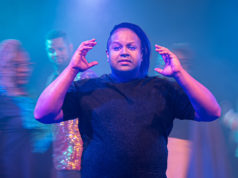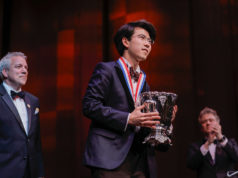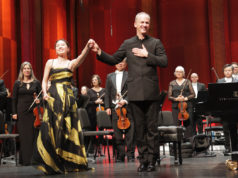Last March, Greg Anderson and Elizabeth Roe, also known as the classical duo Anderson & Roe, sat facing each other at pristine Steinway grand pianos and unleashed a pyrotechnic display of bravado and virtuosity to dozens of concertgoers. The stage was sumptuous and spacious and the venue dark and comfortable. But it wasn’t Bass Performance Hall. Or any other fancy concert hall, for that matter. It was The Live Oak Music Hall & Lounge, a newish Near Southside venue typically populated by indie rockers.
The concert was part of a new initiative by the Van Cliburn Foundation. The 52-year-old nonprofit arts group named for the legendary Fort Worth pianist oversees numerous concert series and educational programs, in addition to, of course, the Van Cliburn International Piano Competition. By taking classical music out of the fancy concert hall and into the community, the foundation is doing its part to remain relevant to people under 50 –– classical music all around the world is suffering from a lack of new listeners. In the process, the foundation is also bringing classical music back to its roots.
Anderson & Roe’s performance inaugurated The Cliburn Sessions, a community-based concert series created to “demystify classical music,” said Jacques Marquis, now into his second year as the foundation’s president and CEO. “With new venues, you get new audiences,” he said. “The artist can interact closely with the audience.”
Venues such as The Live Oak, he continued, are a “perfect fit: very small, very intimate.”
A lot of chamber music, he said, was “written for this musique de salon, like Chopin’s piano works, and wasn’t meant for large venues.”
About 120 people had piled into The Live Oak for Anderson & Roe’s show, ranging in age from the early 20s to the late 60s. Marquis said the sessions aren’t just good for the foundation and Fort Worth — they’re also beneficial for the musicians.
“What I’ve learned the last 20 years is that these artists want to share their love of the music, to do something beyond large concerts, where there is little audience interaction,” he said. “Today, for instance, conductors regularly speak with audiences. So things have changed.”
Along with chatting and joking with concertgoers, Anderson & Roe served up arrangements of works by the likes of Michael Jackson along with Stravinsky and Mozart. While the format was more eclectic than your typical classical music concert, Anderson said it was more historically accurate than it may have seemed.
“When we think of classical music traditions, we are actually far off from what was happening when the music was composed 100-plus years ago,” he said. “Recitals around that time would actually take place in bars and relaxed salon settings. What we see now are really the traditions established in the 1950s, ’60s, and ’70s. So we were actually being historically accurate while having a heck of a lot of fun.”
Roe said The Live Oak was the perfect match for her and her professional partner’s unique take on classical music.
“I loved the venue,” she said. “I could pretend I was a rocker with the backstage lounge, all the lights, and seeing people up close to us enjoying their drinks. It just felt so free and really dynamic because we had such intimate interactions with the crowd. [They] seemed more comfortable cheering and expressing their excitement. In a traditional concert hall there is this unspoken protocol [against heartfelt outbursts], so I liked that the often-rarefied concert atmosphere was demystified and relaxed.”
The great thing about being a music lover in this interconnected world, she added, is that listeners don’t have to conform to past conceptions of what classical music is.
“Different styles will always have their niches,” she said. “If you’re a traditionalist, you can always go to the fancy concert hall.”
The Cliburn Sessions continue on Tuesday, Nov. 11, at The Live Oak with the suspiciously piano-free string trio Time for Three. Over the past 15 years, violinists Nick Kendall and Zach De Pue and double-bassist Ranaan Meyer have established themselves as rebels of sorts by performing arrangements of works by such artists as The Beatles, Katy Perry, Kanye West, and Justin Timberlake, in addition to original compositions and standard repertoire.
The “vibe” of a venue determines the pieces that Time for Three will perform, Kendall said. Drawing listeners to classical musical is always challenging because, like martinis, it’s a taste usually acquired at least a few years into adulthood.
“True understanding and appreciation of these masterworks tends to come later in life,” he said. “When a young person is done with fads and trends, they start looking for deeper things, and classical music is often part of what they find.”
Time for Three, he said, acts as a “gateway” for audiences seeking more intricate and nuanced music, whether it’s traditionally “classical” or complex arrangements and improvisations based on popular tunes.
The Cliburn Sessions rounds out the year with Sybarite5, a string quintet, in December at The Live Oak. And the sessions, Marquis said, are here to stay.
“It’s important for our organization to continually reach out,” he said. “If we do not do it, a lot of people will be missing out on this excellent music.”












